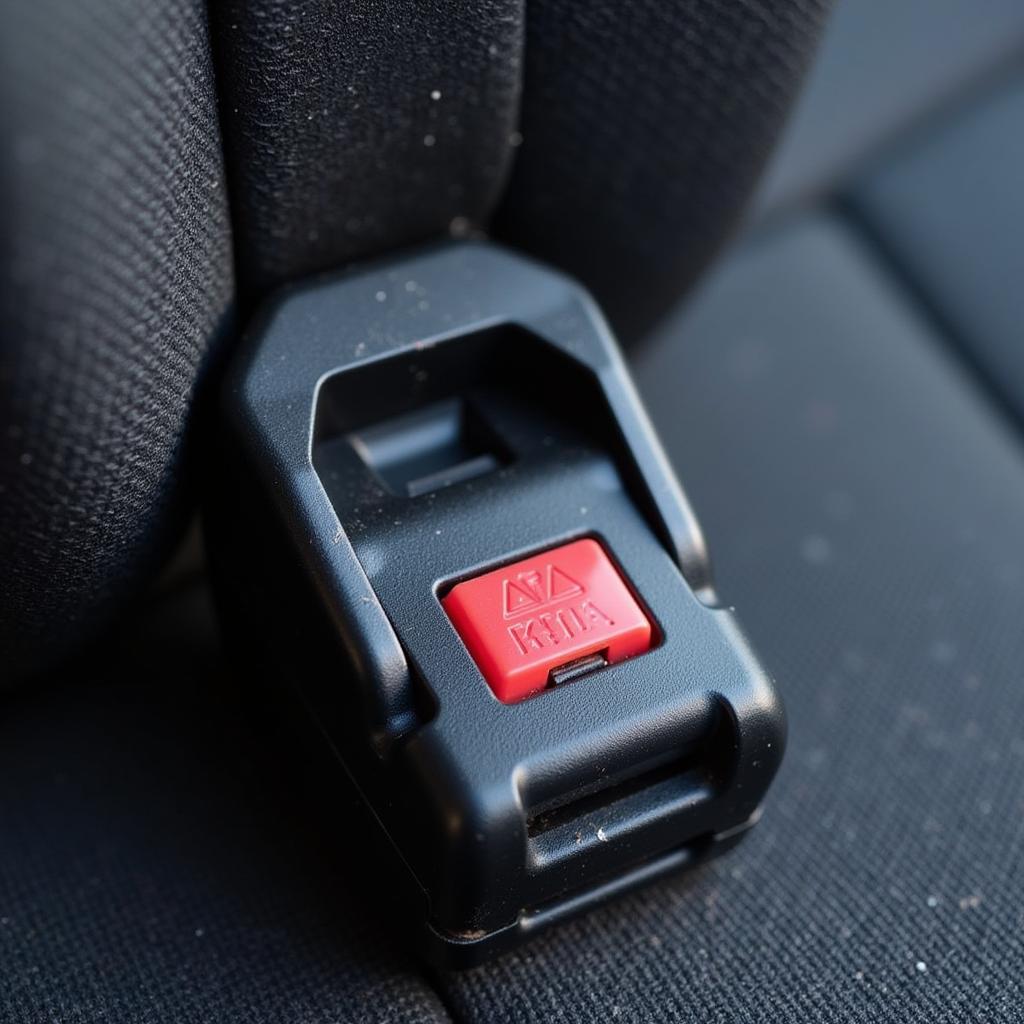The seat belt warning light is a crucial safety feature in your car, reminding you and your passengers to buckle up. However, it can be frustrating when this light stays on or flashes even when everyone is securely fastened. This often signals an underlying issue that needs to be addressed. This comprehensive guide will delve into the common causes of a persistent seat belt warning light and provide practical solutions to help you resolve the issue.
Understanding Your Car’s Seat Belt Warning System
Modern vehicles are equipped with sophisticated seat belt warning systems that go beyond simple visual cues. These systems consist of several components working together:
- Seat Belt Buckle Sensors: These sensors, typically located within the buckle receptacle, detect whether the seat belt is fastened.
- Seat Belt Pretensioners: In the event of a collision, these devices tighten the seat belts to secure occupants firmly against their seats.
- Weight Sensors: Some cars use weight sensors in the passenger seats to determine if someone is occupying the seat and if they meet the weight requirement for airbag deployment.
- Warning Lights and Sounds: The dashboard warning light, often accompanied by an audible chime, is the most apparent part of the system, alerting the driver to unfastened seat belts.
A fault in any of these components can trigger the seat belt warning light, even if all passengers are buckled up correctly.
Common Reasons Your Seat Belt Warning Light Stays On
While a faulty seat belt buckle is often the culprit, there are several other reasons why your seat belt warning light might be illuminating:
- Faulty Seat Belt Buckle/Sensor: Over time, the buckle mechanism can wear out, or the sensor within can malfunction, sending inaccurate signals to the car’s computer.
- Wiring Issues: Damaged or corroded wiring connected to the seat belt system, often under the seats, can disrupt the signal flow, causing the warning light to trigger.
- Faulty Weight Sensor: If your car utilizes weight sensors, a malfunctioning sensor can misinterpret the weight in the passenger seat, leading to a false warning.
- Software Glitch: Like any computer-based system, your car’s software can encounter glitches or errors, potentially affecting the seat belt warning system.
- Aftermarket Modifications: Installing aftermarket seats or modifying the seat belt system without proper care can interfere with the original wiring and sensors, triggering the warning light.
Troubleshooting a Persistent Seat Belt Warning Light
Before rushing to a mechanic, there are several troubleshooting steps you can take to identify the root cause of the problem:
- Check for Obvious Signs: Start with the basics. Ensure all seat belts are properly fastened and that there are no objects placed on the seats that could be triggering the weight sensor.
- Inspect the Seat Belt Buckles: Examine each buckle for any visible damage, dirt, or debris that might be obstructing the connection. Try cleaning the buckles with compressed air and applying electrical contact cleaner.
- Check Under the Seats: Carefully inspect the wiring harnesses under the seats where they connect to the seat belt system. Look for any loose connections, frayed wires, or signs of corrosion.
- Consult Your Car’s Manual: Your vehicle’s owner’s manual can provide specific information about your car’s seat belt warning system, including fuse locations and reset procedures.
When to Seek Professional Help
If the troubleshooting tips don’t resolve the issue, it’s time to consult a professional automotive electrician. They have the specialized diagnostic tools and expertise to:
- Scan for Fault Codes: A professional diagnostic scan can pinpoint the exact component within the seat belt system that’s triggering the warning light.
- Repair or Replace Faulty Components: Based on the diagnostic results, a qualified technician can repair or replace the faulty buckle, sensor, wiring, or any other component causing the issue.
- Perform Software Updates: In some cases, a software update to your car’s system may be necessary to address software glitches affecting the seat belt warning system.
 Faulty Seatbelt Buckle
Faulty Seatbelt Buckle
Remote Diagnostics and Programming: The Future of Car Repair
Advancements in automotive technology have paved the way for remote diagnostics and programming, offering a convenient and efficient way to address car issues, including persistent seat belt warning lights. Here’s how it works:
- Remote Diagnostics: By connecting to your car’s onboard computer remotely, specialized technicians can read diagnostic trouble codes, analyze real-time data, and often identify the root cause of the problem without needing physical access to your vehicle.
- Remote Programming: In situations where a software glitch is causing the seat belt warning light to stay on, remote programming allows technicians to upload and install the latest software updates wirelessly, potentially resolving the issue remotely.
 Remote Car Diagnostics
Remote Car Diagnostics
This approach eliminates the need for a trip to the repair shop, saving you time and hassle. It also allows for faster turnaround times and can be particularly beneficial for addressing software-related issues.
seat belt warning box assembly 2015 subaru outback
Importance of Addressing a Persistent Seat Belt Warning Light
Ignoring a persistent seat belt warning light is not recommended. Here’s why:
- Safety Risks: A malfunctioning seat belt warning system could mean other safety features, such as airbags or seat belt pretensioners, might not deploy correctly in an accident, putting you and your passengers at risk.
- Potential for Further Damage: Ignoring a warning light often allows the underlying issue to worsen over time, potentially leading to more extensive and costly repairs down the line.
- Legal Consequences: In many jurisdictions, driving with a deactivated or malfunctioning seat belt warning system is illegal and could result in fines.
Expert Insight
“Many people underestimate the complexity of modern car safety systems,” says automotive electronics expert, John Smith. “A persistent seat belt warning light is not just an annoyance; it’s a sign that your car’s safety system requires attention. Addressing the issue promptly can prevent more serious problems and ensure your safety on the road.”
signs it’s the alternator not the battery
Conclusion
A seat belt warning light that keeps coming on, even when everyone is buckled up, shouldn’t be ignored. By understanding the common causes, taking simple troubleshooting steps, and seeking professional help when needed, you can resolve the issue and ensure the proper functioning of your car’s vital safety systems. Regular maintenance and prompt attention to warning signs can go a long way in keeping you safe on the road.

